It looks like you're using an Ad Blocker.
Please white-list or disable AboveTopSecret.com in your ad-blocking tool.
Thank you.
Some features of ATS will be disabled while you continue to use an ad-blocker.
share:
Hi ATS,
I have a strange feeling about some of the most remarkable megalithic stonework, found all over the world.. I know that in some cases it has been seen that partly quarried stones were left in situ if the work was abandoned during the operation, and it appears from that evidence that the stones were cut large, carried large, and dressed large at the final building site. However, I now believe that those abandoned stones are red herrings - that they are not what they appear to be, and may indeed have been left in place as a deliberate sign of the presence of the megalithic builders, for the attention of anyone who might come raiding & seeking to usurp control of the territory..
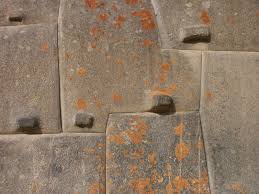
Why do I believe this? After twenty years of reading up on the subject, with a wistful sort of half-memory, a shade of a dream, anamnesis which makes me feel like somehow, I was there.. A past life sort of thing. I won't go into all the reasons why I believe in this as a possibility, but I'll exposit the hypothesis which I favour in regards to the mystery of the stones. The stones stand, they remain, they speak to us from across Time - but they hide secrets which we aren't ready to accept.
So - why the belief in the 'rock-cutting red herring' theory? I actually believe that the Builders cut those stones as markers & signs, a warning regarding the presence of the Builders. But when it comes to actually building the walls, and selecting the stones - why do some have strange knobs sticking out of the main plane of the 'pillow-faced' stones dressed with an outward bulge...?
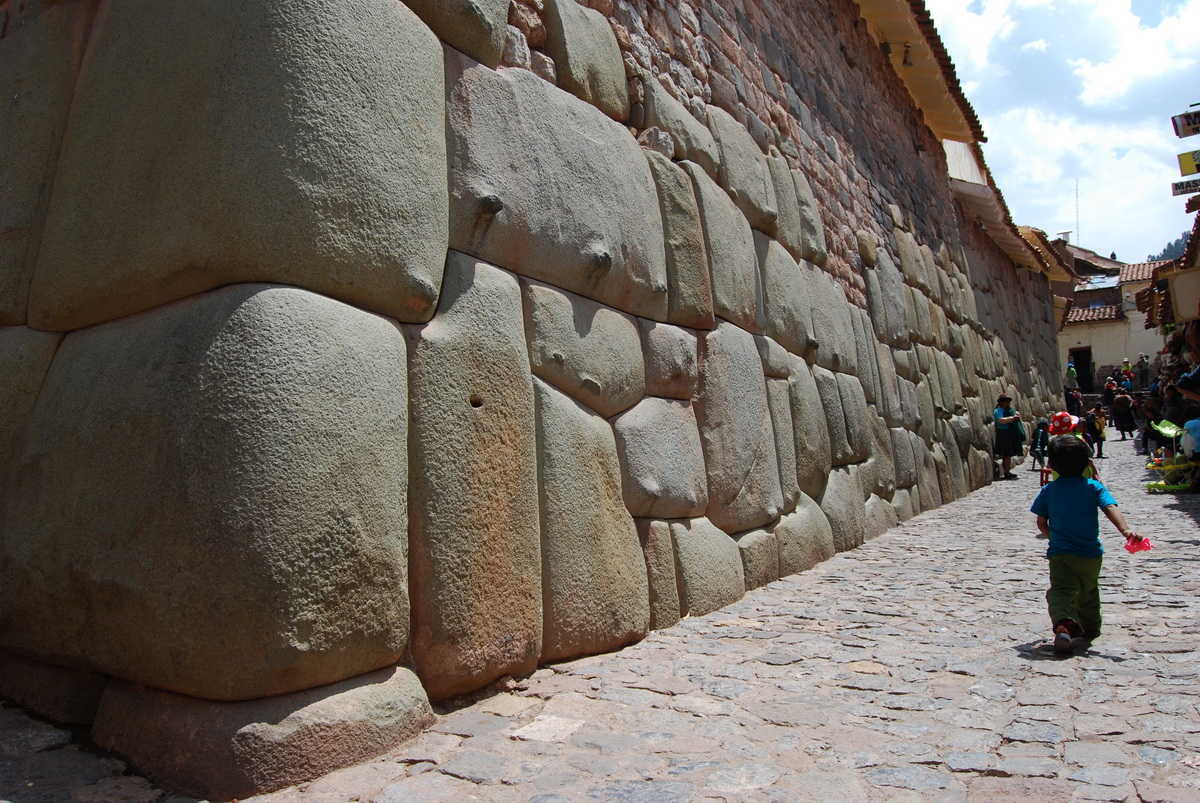
Not all of the stones have these knobs. Why? Did they use two separate techniques for apparent dressing of the stones? Well, I think that yes, some large stones cut straight from the quarry & somehow transported across impossible terrain, for inclusion in the walls. But also, the stones with the strange knobs on - these are NOT natural cut & dressed stones. I believe that the strange knobs are evidence that these stones were in fact created... From dust... Basically, we're looking at an early high technology which would have been immensely practical, in terms of transporting the stone material from quarry to the building site.. What we're looking at is a high quality method of 'concrete casting, au naturelle'. We are looking at pulverised stone, ground to dust at the quarry, and transported with great ease (compared to the feat of transporting huge stones which are total natural cuts) - a continuous stream of servants in great number would relatively quickly deliver loads of pulverised granite to the site, which is then mixed with the requisite solvent which caused the rock dust to adhere to itself, being therefore capable of being cast as a liquid concrete solution, and when the 'stone' is set, the spout into which the admixture was poured, is hammered off, fracturing fairly cleanly but leaving an apparent 'bulge', which is then lightly dressed.

The matter of how the stones were placed is a mystery which I don't yet fully have any answers for, though I have some suspicions. However, on the matter of concretised pulverised stone dust, used with unknown solvents so it could be cast & made to appear as a whole stone once more, especially when dressed to match the bulge & smooth edges of those stones which were actually cut whole, dressed as one stone & transported somehow for inclusion in the walls. These 'natural-cut' stones would have been the cornerstones, &/or perhaps strategically placed so as to strengthen the walls at certain places in the fortifications, which would have therby been incredibly solid & actually quite quick to build, assuming they have a means of pulverising the stone at the quarry & the science knowledge to cast the concretised stone, made to look like it was naturally cut, though in fact it had been poured/cast, broken off at the infill spout, smoothed down slightly, and heaved us into the wall somehow as the main (& cheaper) building blocks.
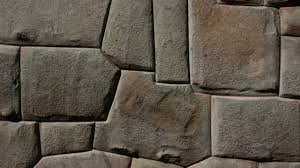
I genuinely believe this is why & how the stones with knobs were created, in order to cheapen & speed up the production of the fortifications, using a constant chain of back & forth slaves to transport the dust, with enough slaves you could deliver one stones' worth of dust (on the back of two donkeys being led by the slave) every two minutes, perhaps. With the right conditions at the building site you could knock up these walls pretty quickly. Analysis of the two types of stone (suspected concretised, and suspected 'natural cut') could be carried out at the microscopic scale in order to determine if there are factors which indeed indicate a different microstructure, despite having come from the same quarry, etc..
Thanks for listening!
FITO.
I have a strange feeling about some of the most remarkable megalithic stonework, found all over the world.. I know that in some cases it has been seen that partly quarried stones were left in situ if the work was abandoned during the operation, and it appears from that evidence that the stones were cut large, carried large, and dressed large at the final building site. However, I now believe that those abandoned stones are red herrings - that they are not what they appear to be, and may indeed have been left in place as a deliberate sign of the presence of the megalithic builders, for the attention of anyone who might come raiding & seeking to usurp control of the territory..

Why do I believe this? After twenty years of reading up on the subject, with a wistful sort of half-memory, a shade of a dream, anamnesis which makes me feel like somehow, I was there.. A past life sort of thing. I won't go into all the reasons why I believe in this as a possibility, but I'll exposit the hypothesis which I favour in regards to the mystery of the stones. The stones stand, they remain, they speak to us from across Time - but they hide secrets which we aren't ready to accept.
So - why the belief in the 'rock-cutting red herring' theory? I actually believe that the Builders cut those stones as markers & signs, a warning regarding the presence of the Builders. But when it comes to actually building the walls, and selecting the stones - why do some have strange knobs sticking out of the main plane of the 'pillow-faced' stones dressed with an outward bulge...?

Not all of the stones have these knobs. Why? Did they use two separate techniques for apparent dressing of the stones? Well, I think that yes, some large stones cut straight from the quarry & somehow transported across impossible terrain, for inclusion in the walls. But also, the stones with the strange knobs on - these are NOT natural cut & dressed stones. I believe that the strange knobs are evidence that these stones were in fact created... From dust... Basically, we're looking at an early high technology which would have been immensely practical, in terms of transporting the stone material from quarry to the building site.. What we're looking at is a high quality method of 'concrete casting, au naturelle'. We are looking at pulverised stone, ground to dust at the quarry, and transported with great ease (compared to the feat of transporting huge stones which are total natural cuts) - a continuous stream of servants in great number would relatively quickly deliver loads of pulverised granite to the site, which is then mixed with the requisite solvent which caused the rock dust to adhere to itself, being therefore capable of being cast as a liquid concrete solution, and when the 'stone' is set, the spout into which the admixture was poured, is hammered off, fracturing fairly cleanly but leaving an apparent 'bulge', which is then lightly dressed.

The matter of how the stones were placed is a mystery which I don't yet fully have any answers for, though I have some suspicions. However, on the matter of concretised pulverised stone dust, used with unknown solvents so it could be cast & made to appear as a whole stone once more, especially when dressed to match the bulge & smooth edges of those stones which were actually cut whole, dressed as one stone & transported somehow for inclusion in the walls. These 'natural-cut' stones would have been the cornerstones, &/or perhaps strategically placed so as to strengthen the walls at certain places in the fortifications, which would have therby been incredibly solid & actually quite quick to build, assuming they have a means of pulverising the stone at the quarry & the science knowledge to cast the concretised stone, made to look like it was naturally cut, though in fact it had been poured/cast, broken off at the infill spout, smoothed down slightly, and heaved us into the wall somehow as the main (& cheaper) building blocks.

I genuinely believe this is why & how the stones with knobs were created, in order to cheapen & speed up the production of the fortifications, using a constant chain of back & forth slaves to transport the dust, with enough slaves you could deliver one stones' worth of dust (on the back of two donkeys being led by the slave) every two minutes, perhaps. With the right conditions at the building site you could knock up these walls pretty quickly. Analysis of the two types of stone (suspected concretised, and suspected 'natural cut') could be carried out at the microscopic scale in order to determine if there are factors which indeed indicate a different microstructure, despite having come from the same quarry, etc..
Thanks for listening!
FITO.
edit on AprilWednesday1914CDT06America/Chicago-050025 by FlyInTheOintment because: spelling
Some of the cements used in the ancient Italian structures were made from a clay based cement. They look like stones. I had a friend that grew up in
Italy and was a Mason and they discussed this strange lost recipe for cement thousands of years ago. The Masons of the time apparently moved
somewhere else on the continent for some reason. I found some mortar and rocks here that resemble the old cement and mortar found in Italy. I
researched this and found they have found how to recreate the type of cement but not exact, because they would never have had been able to create the
binding liquid that was used back then to add to the mix. I think that they may have been able if they used a common element of the time...Urine.
Why so many different sizes and shapes though? Are any of the knobby blocks the exact same size? Why would they go and make hundreds and hundreds of
different sized and shaped molds?
edit on 10-4-2019 by KansasGirl because: (no reason given)
As Louis C.K. once said, it's amazing how many problems you can solve by just throwing enough human death and suffering at them until they go away.
a reply to: KansasGirl
It's a good question - I think they deliberately crafted the walls with non-uniform sizing in order to 'earthquake-proof' the walls, as well as to fortify to the point of resisting all siege engines (heck, even battle cruisers).
I accept that the theory is incomplete - the unusual sizing may have been managed by CAD models, equivalent to whatever technology they had in place. It's an enduring mystery, but I am convinced they used some sort of technology to make the stones settle into place within the wall as abstract shapes in order to strengthen the walls. It's like they altered the mould to match whatever size & shape they needed next - and the stone was pushed into place after which it settled down in situ & filled the gaps between the existing stones perfectly, meaning you can't fit a piece of paper between them.
It really is a fasicinating mystery, and I feel that the cement-type technology is one aspect of the solution. The walls were so perfectly fitted, in a manner that resists thousands of years' worth of earthquakes, fitted perfectly & with some evidence that they may have been fitted according to a very precise design which was entirely bespoke, block by block. If the process was FULLY AUTOMATED then there is a chance that this bespoke & seemingly tricky method of casting unique sizes & shapes in an interlocking multi-angled manner, then perhaps the mystery is largely resolved. We would need to credit the Builders with some remarkable technological capabilities if that were to be the case - I have no problem with doing so, believing that there is sufficient evidence that the most ancient Builders were in fact highly advanced beings who implemented a massively controlled & technologically-supported civilisation, utilising human sources of labour in many areas, treating us no better than soulless automatons. Thankfully something changed, and we were in essence liberated from that situation. Cosmic revolution, civil war, exile for the losers...?
It's a good question - I think they deliberately crafted the walls with non-uniform sizing in order to 'earthquake-proof' the walls, as well as to fortify to the point of resisting all siege engines (heck, even battle cruisers).
I accept that the theory is incomplete - the unusual sizing may have been managed by CAD models, equivalent to whatever technology they had in place. It's an enduring mystery, but I am convinced they used some sort of technology to make the stones settle into place within the wall as abstract shapes in order to strengthen the walls. It's like they altered the mould to match whatever size & shape they needed next - and the stone was pushed into place after which it settled down in situ & filled the gaps between the existing stones perfectly, meaning you can't fit a piece of paper between them.
It really is a fasicinating mystery, and I feel that the cement-type technology is one aspect of the solution. The walls were so perfectly fitted, in a manner that resists thousands of years' worth of earthquakes, fitted perfectly & with some evidence that they may have been fitted according to a very precise design which was entirely bespoke, block by block. If the process was FULLY AUTOMATED then there is a chance that this bespoke & seemingly tricky method of casting unique sizes & shapes in an interlocking multi-angled manner, then perhaps the mystery is largely resolved. We would need to credit the Builders with some remarkable technological capabilities if that were to be the case - I have no problem with doing so, believing that there is sufficient evidence that the most ancient Builders were in fact highly advanced beings who implemented a massively controlled & technologically-supported civilisation, utilising human sources of labour in many areas, treating us no better than soulless automatons. Thankfully something changed, and we were in essence liberated from that situation. Cosmic revolution, civil war, exile for the losers...?
a reply to: FlyInTheOintment
Why not include an element of vibration to the process, with the still slurry-like perhaps 'stones' in place, vibrate the mix; so that the slurry fills all the crevices, and comes directly up against the adjacent' stones and / or mold' perfectly, then hardens later?
You could put a vibrating metal rod into the slurry maybe, or agitate it to vibrate some other way....
That could be a way to get the stones to fit perfectly up against each other, at least.
Why not include an element of vibration to the process, with the still slurry-like perhaps 'stones' in place, vibrate the mix; so that the slurry fills all the crevices, and comes directly up against the adjacent' stones and / or mold' perfectly, then hardens later?
You could put a vibrating metal rod into the slurry maybe, or agitate it to vibrate some other way....
That could be a way to get the stones to fit perfectly up against each other, at least.
If I’m not mistaking there are some megalithic structures in Yangshang China that were cut in place from solid rock, yet they too have these
“knobs”, so that would not only rule out that they were for tranportation, but it also dismisses the casting theory, because the structure I am
refering to was cut from existing rock that is part of the bedrock.
edit on 11-4-2019 by 2Faced because: You know....
Double (trouble) post. Some weird hanging error caused me to double-tap the reply button.
edit on 11-4-2019 by 2Faced because:
Slowarseloadingtimetimetoperhapsrebootthisdamntablet
A lot of these rocks look very impressive, but you have to remember that a lot of them are only facings. They would shape and put up the facing rocks
and then dump a bunch of garbage behind them to fill them up. Not that it wouldn't be difficult, but if you imagine them not working with a massive
shaped boulder but instead what essentially a thick tile, then you can kind of see how it might be doable with a smaller number of people on the
job.
edit on 11-4-2019 by Blue Shift because: (no reason given)
originally posted by: Blue Shift
A lot of these rocks look very impressive, but you have to remember that a lot of them are only facings. They would shape and put up the facing rocks and then dump a bunch of garbage behind them to fill them up. Not that it wouldn't be difficult, but if you imagine them not working with a massive shaped boulder but instead what essentially a thick tile, then you can kind of see how it might be doable with a smaller number of people on the job.
See "chamber method": link
Harte
originally posted by: Fowlerstoad
a reply to: FlyInTheOintment
Why not include an element of vibration to the process, with the still slurry-like perhaps 'stones' in place, vibrate the mix; so that the slurry fills all the crevices, and comes directly up against the adjacent' stones and / or mold' perfectly, then hardens later?
You could put a vibrating metal rod into the slurry maybe, or agitate it to vibrate some other way....
That could be a way to get the stones to fit perfectly up against each other, at least.
That would work, but then we wouldn't have the gaps between stones and the layers of mortar that are plain to see.
Harte
originally posted by: 2Faced
If I’m not mistaking there are some megalithic structures in Yangshang China that were cut in place from solid rock, yet they too have these “knobs”, so that would not only rule out that they were for tranportation, but it also dismisses the casting theory, because the structure I am refering to was cut from existing rock that is part of the bedrock.
The knobs were for transportation. The megalith you're talking about is an unfinished stele that has two parts, both left in the quarry when the project was abandoned in the early 1400's - AD.
Harte
originally posted by: Harte
originally posted by: 2Faced
If I’m not mistaking there are some megalithic structures in Yangshang China that were cut in place from solid rock, yet they too have these “knobs”, so that would not only rule out that they were for tranportation, but it also dismisses the casting theory, because the structure I am refering to was cut from existing rock that is part of the bedrock.
The knobs were for transportation. The megalith you're talking about is an unfinished stele that has two parts, both left in the quarry when the project was abandoned in the early 1400's - AD.
Harte
Still not convinced. This stand-alone structure was not transported.
3.bp.blogspot.com...
originally posted by: 2Faced
originally posted by: Harte
originally posted by: 2Faced
If I’m not mistaking there are some megalithic structures in Yangshang China that were cut in place from solid rock, yet they too have these “knobs”, so that would not only rule out that they were for tranportation, but it also dismisses the casting theory, because the structure I am refering to was cut from existing rock that is part of the bedrock.
The knobs were for transportation. The megalith you're talking about is an unfinished stele that has two parts, both left in the quarry when the project was abandoned in the early 1400's - AD.
Harte
Still not convinced. This stand-alone structure was not transported.
3.bp.blogspot.com...
That is true. The project was abandoned.
You realize this was within the historical period (when they had writing) and it was written about at the time?
Harte
If the knobs were of any real use, they would be present
on every large block, not just some.
The highly polished, flat granite pieces in Egypt and in
Puma Punku were created with a device, lost, that they
used to make the machined surfaces.
The pillow pieces of rock are beautifully crafted using
lost technology as the hardness preculdes Bronze-age
peoples to create them. The Inca who reconstructed
some of the walls could not even use as large blocks
as the original wall did.
The new discovery in lake Titicaca indicates activity
there pre-Inca, perhaps for 2000 years. It is not
inconcievable that other, older cultures existed
where there is no evidence of them that still exists.
on every large block, not just some.
The highly polished, flat granite pieces in Egypt and in
Puma Punku were created with a device, lost, that they
used to make the machined surfaces.
The pillow pieces of rock are beautifully crafted using
lost technology as the hardness preculdes Bronze-age
peoples to create them. The Inca who reconstructed
some of the walls could not even use as large blocks
as the original wall did.
The new discovery in lake Titicaca indicates activity
there pre-Inca, perhaps for 2000 years. It is not
inconcievable that other, older cultures existed
where there is no evidence of them that still exists.
originally posted by: 2Faced
Still not convinced. This stand-alone structure was not transported.
3.bp.blogspot.com...
The pyramid of Menkaure has a few courses of granite casing stones that also feature these knobs in various shapes, sizes and positions. These are very similar to the south american stonework, closeup views of the casing stones also show some interesting toolmarks.
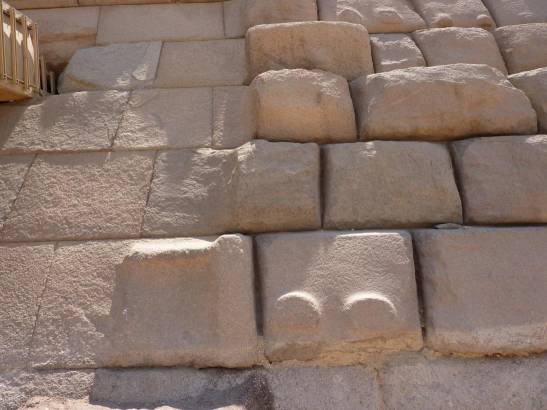
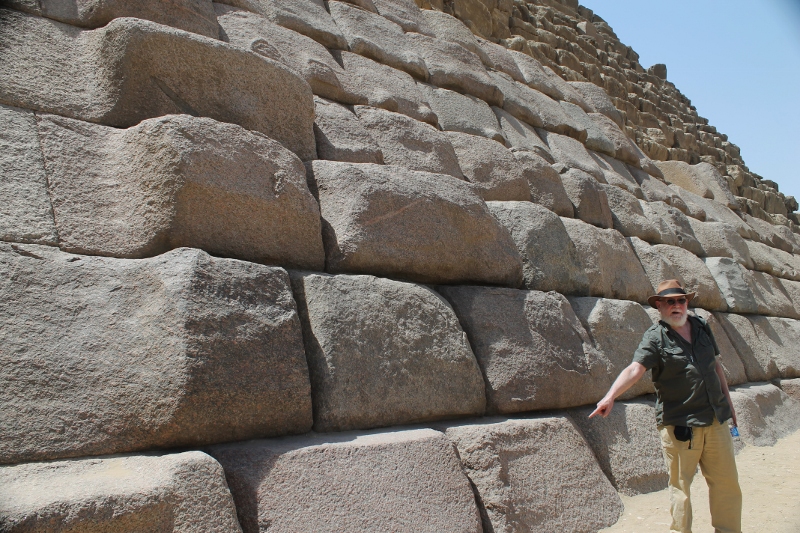
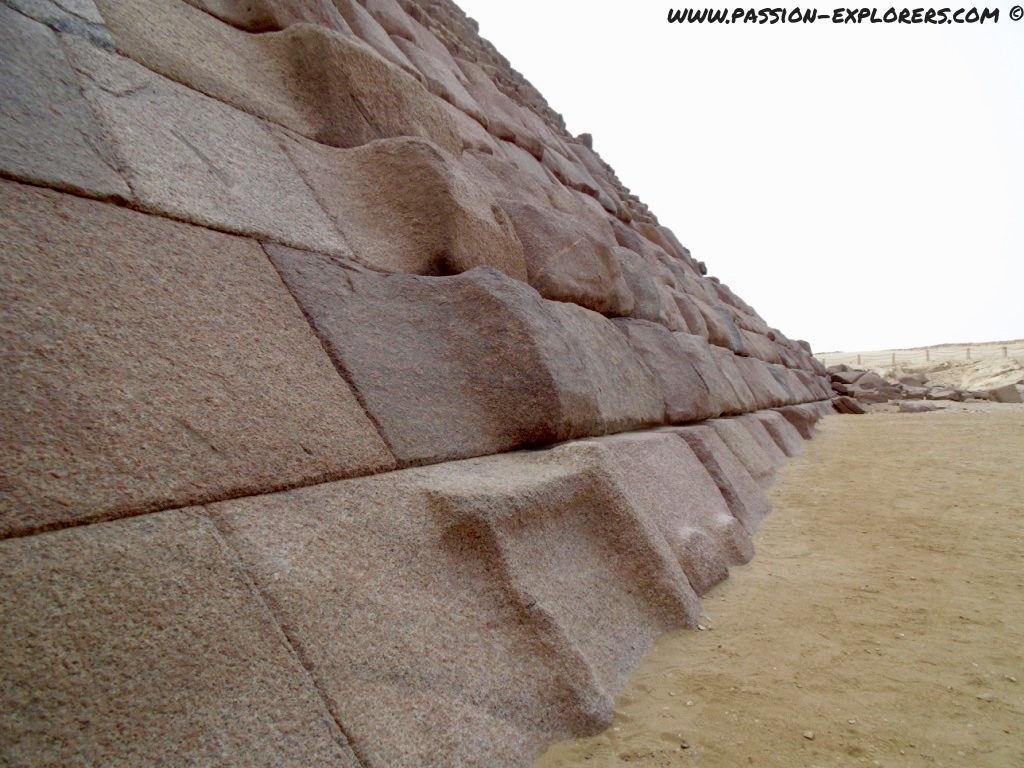
Close to the entrance area some of them have been dressed down incl. removal of the knobs. I'm not sure when this was done and whether the original blocks were the same as those with the rough surfaces, but that's probably what we must assume when looking at the images above.
originally posted by: 2Faced
Nevertheless,
There are more places where the knobs are present on random rocks, while on other much larger rocks they are absent. So there are perhaps two era’s and subsequently two possible possibilities or reasons for their pressence.
a reply to: Harte
Knobs are supposed to be smoothed off.
Often this practice took shortcuts.
Looking at the pyramid of Menkaure in Jeep3r's post, I'd say they gave up the smoothing out after a while once the king was safely entombed. Moved on to other things the new king demanded or what have you.
IMO, there is no mystery to these knobs at all.
Harte
Right, that's it - I'm claiming a win for the 'mystery' crowd - Harte did not directly refute any of what I posted as the OP. Therefore he is subtly
informing me that my hypothesis is at least partially correct - though he has refuted many assertions from members who posted their considerations in
response to the OP. As we all know that Harte is a 'friend' of the Monsanto-Bayer-Boeing-DARPA-NASA-Washington_DC PLC Cartel, it is clear that he's
not permitted to outright agree with my claims. Instead, he's gone as close to the bone as his contract permits, by stating nothing in response to my
assertions, and only obliquely refuting some of the comments made in response to my hypothesis.
Huzzah!
[/sarc]
Thanks Harte, this little 'victory' (even if delusional) has made the past five years of pain on ATS well, well, worth it.
Huzzah!
[/sarc]
Thanks Harte, this little 'victory' (even if delusional) has made the past five years of pain on ATS well, well, worth it.
new topics
-
Does the Trump win mean No More Taylor Swift??
2024 Elections: 16 minutes ago -
Trump-appointed judge blocks Biden administration overtime rule
Social Issues and Civil Unrest: 2 hours ago -
Don't cry do Cryo instead
General Chit Chat: 7 hours ago -
Tariffs all around, Except for ...
Dreams & Predictions: 9 hours ago
top topics
-
Gen Flynn's Sister and her cohort blow the whistle on DHS/CBP involvement in child trafficking.
Whistle Blowers and Leaked Documents: 14 hours ago, 8 flags -
Don't cry do Cryo instead
General Chit Chat: 7 hours ago, 7 flags -
Anybody else using Pomodoro time management technique?
General Chit Chat: 16 hours ago, 3 flags -
Tariffs all around, Except for ...
Dreams & Predictions: 9 hours ago, 3 flags -
Trump-appointed judge blocks Biden administration overtime rule
Social Issues and Civil Unrest: 2 hours ago, 3 flags -
Does the Trump win mean No More Taylor Swift??
2024 Elections: 16 minutes ago, 1 flags
active topics
-
Does the Trump win mean No More Taylor Swift??
2024 Elections • 1 • : JJproductions -
Trump sues media outlets -- 10 Billion Dollar lawsuit
US Political Madness • 45 • : Oldcarpy2 -
Anybody else using Pomodoro time management technique?
General Chit Chat • 10 • : mysterioustranger -
Mike Tyson returns 11-15-24
World Sports • 56 • : Flyingclaydisk -
Don't cry do Cryo instead
General Chit Chat • 5 • : Flyingclaydisk -
WATCH LIVE: US Congress hearing on UFOs, unidentified anomalous phenomena
Aliens and UFOs • 87 • : Lazy88 -
Trump-appointed judge blocks Biden administration overtime rule
Social Issues and Civil Unrest • 1 • : WeMustCare -
How can you defend yourself when the police will not tell you what you did?
Posse Comitatus • 86 • : ADVISOR -
Tariffs all around, Except for ...
Dreams & Predictions • 14 • : Flyingclaydisk -
The Acronym Game .. Pt.4
General Chit Chat • 963 • : JJproductions
